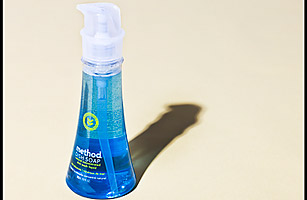
(2 of 2)
The founders initially financed the effort with $90,000 in savings and money from friends and family. In 2001 they received $1 million from private investors, including Tim Koogle, the former chairman and CEO of Yahoo, and it couldn't have come a moment too soon; at the time they had $16 in the bank and with $300,000 on their credit cards, they couldn't even charge a celebratory dinner after signing the deal.)
Method used the new funds to hire famed industrial designer Karim Rashid, whom they emailed cold and asked for his help to "reinvent" the dish soap bottle that sits on every sink. Rashid did just that, creating unique bottles, including one that looked like a bowling pin, which won attention — and opened doors, namely a 90-store trial in Target in 2002.
"The biggest impact they've had is to get companies and consumers to rethink what a product looks like and where you keep it," says Lynn Dornblaser, Director, and new product trend expert at Mintel, a market research firm in Chicago. "It was the first time you wanted to leave a package for something as prosaic as dish soap out on the counter."
Innovation, however, can come with a price. The bowling pin dish soap looked great, yet it leaked onto store shelves when consumers pulled off a seal to smell the product. The founders and their friends dashed from Target to Target cleaning up the spills with paper towels. ("I have nightmares still," says Ryan.) And, some experiments had poor results: A 2006 foray into personal care like shaving creams and moisturizing soaps was ended within three years and a foray into air fresheners was similarly shelved as the pair faced tough competition in this crowded category. "They went too far too fast," says Mintel's Dornblaser, "but they're not done yet."
While few companies other than eco-pioneer Seventh Generation (which makes both cleaning products and paper goods) were interested in the green cleaning space when Method started, giant competitors have since recognized profit and purpose in this pursuit. A 2008 ban on phosphates that has been adopted by more and more states each year has forced many cleaning product companies to reformulate their offerings. Now, the green cleaning products market is expected to grow to $623 million in retail sales in 2013, rising to 30% of the household cleaning market, from just a 3% share in 2008, according to research group Mintel.
The growth is driven by the entry of far bigger companies, including S.C. Johnson, maker of Windex, which in 2008 acquired the earth friendly Mrs. Meyer's brand and also launched its own line of products made of plant-based ingredients. There's also a green Martha Stewart line owned by The Hain Celestial Group. But it's clear that Method is holding its own. Last year, Clorox, which launched its Green Works line in 2008, sent Method a cease-and-desist letter for using a daisy, which it claimed as its trademark, in its marketing. Method, which had been using the daisy in ads for six years, responded with a cheeky marketing campaign in which people voted on who "owned" the daisy: Clorox, Method or Mother Nature. Mother Nature won, but so did Method. They have not heard anything from Clorox since then. (Clorox is not commenting on the dispute.)
Looking ahead, Method isn't looking at the competition, but towards new products. It launched a new laundry detergent (8X concentrated) and new dish soap refill pouches that can be recycled. It has also partnered with Disney on Minnie and Mickey Mouse-shaped bottles that came out in this Spring. Most of all, the company is staying focused on its original mission — to clean the home; they say there's still a lot of work to be done. "People ask us to do toothpaste and a lot of people would buy it, but we are still a small player in a big category with a lot of room to grow," says Lowry.